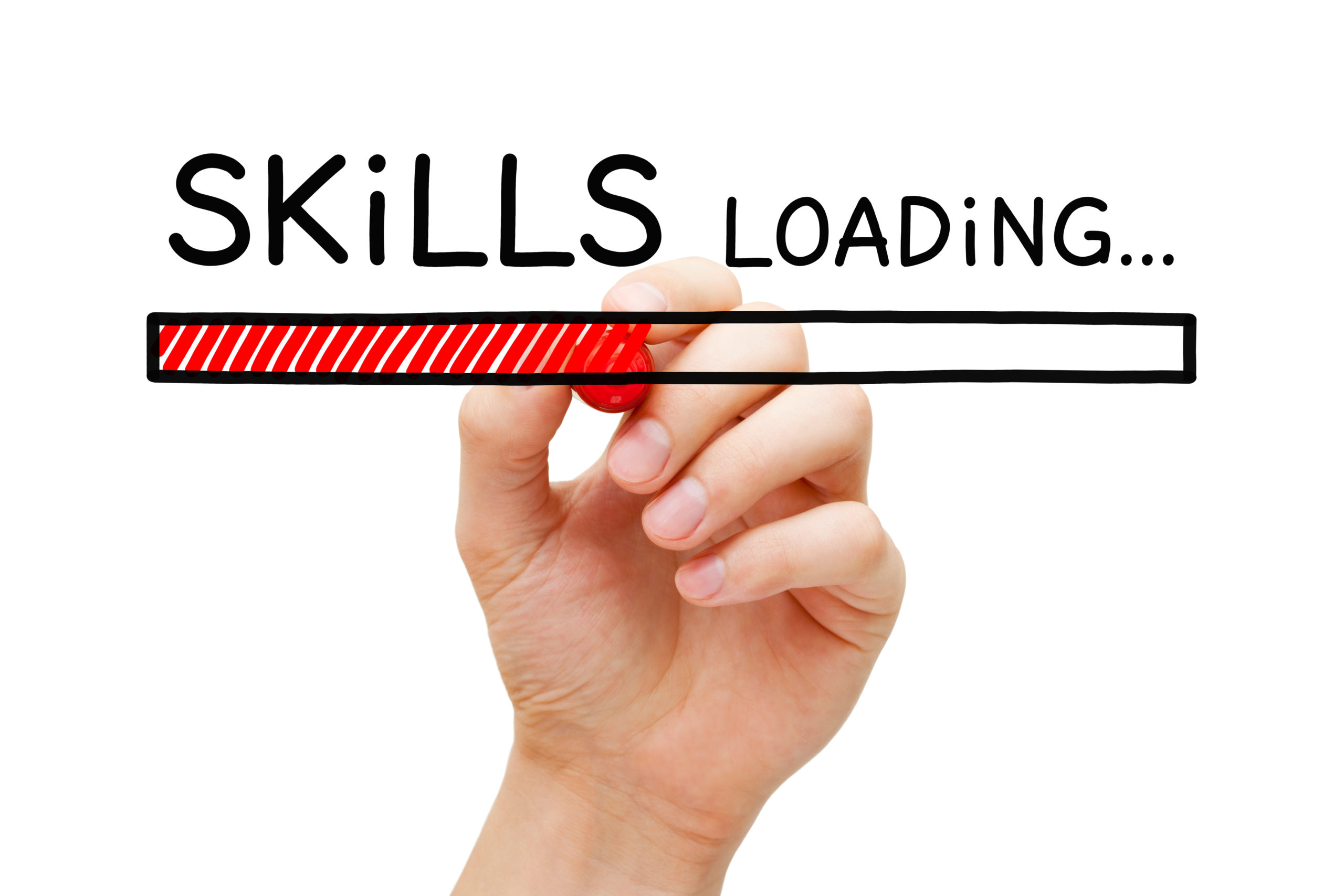How To Succeed At A Career Shift With A Skills-Based Resume
You deserve a job that you love! Have you been in the same industry for years, and are now feeling like it’s time for a change? Job seekers looking to make a major shift often face unique challenges when it comes to updating their resumes. With the increasing use of Applicant Tracking Systems (ATS) in today’s hiring processes, traditional or broadly-focused resumes aren’t cutting it anymore. If you’re proactively searching for jobs in a totally new field, a skills-based resume is the most effective way to present yourself to hiring managers and recruiters. Below we’ll dive into the “hows” and “whys” of everything you need to do to ensure you position yourself for the job you want with the perfect skills-based resume.
Step 1: Visualize what’s next.
The first thing to do is sit down and think about what you want. What job would make you happy? Would it be a similar position, or something completely different? Maybe you’re not looking for a different role, but instead, want to change industries while doing something similar.
Is your vision a little cloudy? That’s ok! A lot of people struggle with visualizing what comes next. If you’re having trouble, you can try taking some career or personality assessments, asking friends, family, or coworkers for insights, or working with a career coach. Here is one of our favorite personality assessments: Berke Personality Assessments. Gallup’s CliftonStrengths is also a good one for your workplace personality.
An alternative exercise would be to look at companies or organizations that you like or would want to work for. What jobs do they have posted that you would want to do? Compare those job descriptions to your current skill set. Make lists. Toss around pros and cons.
Whatever the case may be, it’s important to know what you’re aiming at before starting your skills-based resume writing journey. If you tried one of our suggestions above and you are still unsure of your new direction, then try a different one. Don’t let your uncertainty prevent you from exploring and identifying a new direction if you are unhappy in your current role. It may come to you quickly or it may take a little time, but it will come!
Don’t let your uncertainty prevent you from exploring and identifying a new direction if you are unhappy in your current role.
Step 2: Research available jobs.
The next step is to go online and search for potential job opportunities. Keep in mind, the more your present skill set matches the responsibilities of your desired position, the easier it will be to make the shift. However, you shouldn’t feel that you need to limit yourself if you lack certain skills necessary for the position you desire. Leveraging your existing experience and expertise is important, but keep in mind that new skills can be learned. There are so many opportunities for training and professional development—the sky is truly the limit.
We recommend LinkedIn as a great place to find job postings. It’s one of the top resources for job searching on a spam-free, high-quality platform. If you are searching in more of a niche industry, another good place to look is Indeed.com as it usually has a large number of job postings for you to evaluate.
Sometimes looking at job listings can be overwhelming. There’s so many…. One thing you can do to help is by making a separate document in which you copy and paste responsibilities from listings that you feel confident you can do. Same thing with qualifications and skills. Creating a document that has everything you are qualified for can be a big confidence boost but also help you see what areas your skill set is best for.
Step 3: Identify desired skills
Now that you’ve sourced a few potential jobs that are close to your desired field, it’s time to start learning more about what skills may be needed for these positions. LinkedIn is a powerful resource—take advantage of it! It has an extensive list of skills that are conveniently categorized by profession and industry. When searching through listings, it will actually tell you exactly what skills you have and identify those that are missing!
One thing that will help with identifying these skills is to know that skills come in two different forms: soft skills and hard skills. Soft skills are things like: Written/Verbal Communication, Professionalism, and Collaborative; they are often adjectives and also very transferable. Hard skills are the skills that are specific to the industry and role. For example, some hard skills that are good to include for a marketing job could be: Brand Positioning, Performance Monitoring, and Content Development. It’s important to have both on your resume. When changing industries though, hard skills can be a lot tougher to show prior experience with. And that’s ok. Include what you can but make sure you focus on the soft skills that you have used before. Get creative if you need to!
When finished with this step, you should have a list of 30-50+ skills that frequently occur in your target jobs.
Step 4: Pinpoint your transferable skills.
Start this step by listing out all of your current skills. The exercise from Step 2 will help with this. Go through the document you created and find soft and hard skills that are mentioned. You can also use a job description for current or past roles (or for roles that are similar to yours) to help identify additional skills.
Then, assess which ones are relevant to the role and industry you are interested in. These skills are commonly referred to as “transferable skills.” It’s important to be less specific when writing bullets on a skills-based resume as you want to sell why you’re capable of diving into something totally new to you.
The last part of this step is to note where the skill lists overlap. Which desired skills do you already have experience with? Note those ones and have that list ready for the next step. Also, are there any on the desired skill list that you don’t have experience with but feel that you should? It’s time to hit the books! Udemy, LinkedIn Learning Courses (f/k/a Lynda.com), Coursera, and other educational sites can be a great place to start getting some familiarity with these skills.
Step 5: Creating the outline for your skills-based resume
Once you have narrowed your search down and ascertained your transferable skills, it’s time to rework your resume. A skills-based resume highlights your unique expertise rather than how many years of experience you have in one field. In this way, you are shifting their attention to how and why you are capable of doing the job instead of the positions you have held and for how long. The positions you have held and for how long are important and you should include that information but you don’t want your work history to be the focus of your resume.
Looking at the list of skills you are going to include on the new resume, what themes do you see? How can they be grouped together? Look for 3-4 categories (4-5 if onto two pages) that aptly group your skill set together.
It’s very important to highlight all your transferable skills in your new resume. Situating those skills in the forefront will make it easier for recruiters or potential employers to see what qualifies you to make the career shift. You can do this by incorporating them into your summary, bullet points, and even an “Areas of Expertise” section.
Step 6: Write it!
When drafting a skills-based resume, focus on creating bullet points that “show” your strengths/expertise in four to six specific areas that are relevant to your desired position. We recommend building a “Core Qualifications” section that sits directly below your summary and above your work history. Instead of including bullets for each job, you’ll instead highlight what you’ve done, what skills you’ve used, and what you bring to the table in a carefully categorized way. Our suggestion is to pull the top four or five skills you’d like to showcase and start there. For example, some valuable transferable skills include: Project Management, Quality & Compliance Oversight, Critical Thinking & Problem Solving, Client Relations & Customer Service. You can combine and condense for areas that overlap and really help your resume shine.
In addition to your transferable skills, you’ll want to focus on the impact you’ve had throughout your career. Even if an accomplishment isn’t specifically related to the new field, it’s still valuable to note it. Which inventor would you invest in, or hire to work for you? Inventor A, who hands you a list of materials, tools, and other equipment he uses to invent with? Or Inventor B, who hands you a paper highlighting all of her inventions and how they were developed? There’s no better way to demonstrate your skills to someone on paper than to show what you accomplished by using them!
There’s no better way to demonstrate your skills to someone on paper than to show what you accomplished by using them!
Step 7: Apply!
Everything you have done so far is meaningless if you don’t put yourself out there! Now that you have a powerful and effective skills-based resume, it’s time to put it to use. Remember, although you may think you’ll never be considered for the job because you don’t have the “right” job title or because all your experience was in another industry, employers are looking for quality candidates with potential so don’t let that stop you from applying. The most important thing is to be confident! If you know you can do the job and you took the time to demonstrate just how and why you are capable in your new skills-based resume, the fact that you don’t have the right job title on your resume or that your work was in another industry should never stop you from applying. It’s rudimentary but it doesn’t mean it isn’t true—you’ll never know if you’ll get the job if you don’t apply. If you take the time to think it through and carefully describe your collective experience as well as the scope and impact of your past work (i.e. why your past work mattered) as it applies to your unique ability to fulfill the responsibilities of the new role, you can and will succeed!
Pro Tip: Don’t wait too long to apply! The longer an opportunity has been open, the more competitive it likely will be. It’s to your advantage to get your application in early, and with your new skills-based resume, one that quickly and concisely demonstrates your ability to fulfill their needs, successfully making a career shift is absolutely within your reach!
One last thing.
Keep at it, and don’t give up! Remember, rejection is a part of the process. It may be unpleasant and it’s definitely disappointing, but it’s an aspect of every job search and despite anything to the contrary, it happens to everyone. I mean, if everyone got a “yes” every time they applied for a job, there would be tens of millions of paid movie reviewers, taste testers, travel bloggers, astronauts, multinational CEOs, and well—you get the point.
Have a question? Feel free to send it to us, we’re happy to help! Just send your question in an email to: info@careerlaunch.pro and we’ll get back to you! And hey, who knows? If we think it’s a question that others may have too, maybe we’ll use it in a future post and give you a shout-out for the idea! For more information on how we might be able to help you with your career shift or any other resume, job search, or career development related questions, we’re happy to give you a call to discuss! You can schedule a time for us to talk at https://careerlaunch.pro/calendar/.
 About The Author
About The Author
Adam Curtis
Director of Brand Strategy
To avoid watching the final season of Game of Thrones, Adam keeps himself busy engaging our marketing, recruiting, and customer experience frameworks. While he’s often behind the scenes pulling the strings, his insight, experience, and job search expertise shine through in efforts to expand brand reach and serve as a driving force behind many of our endeavors. Connect with Adam on LinkedIn.










